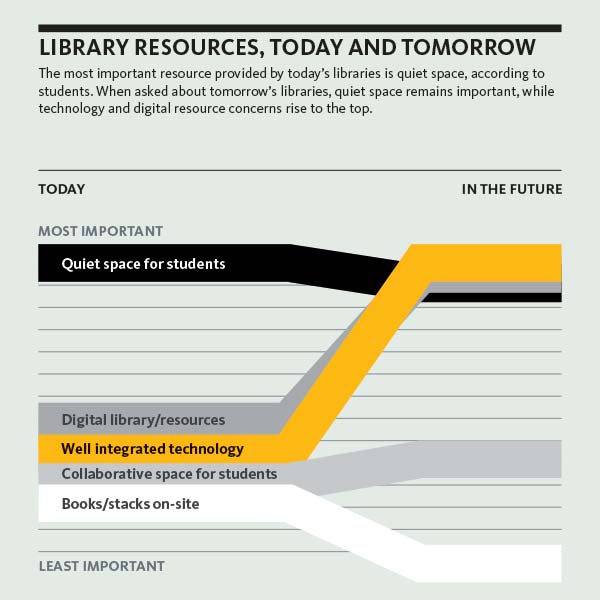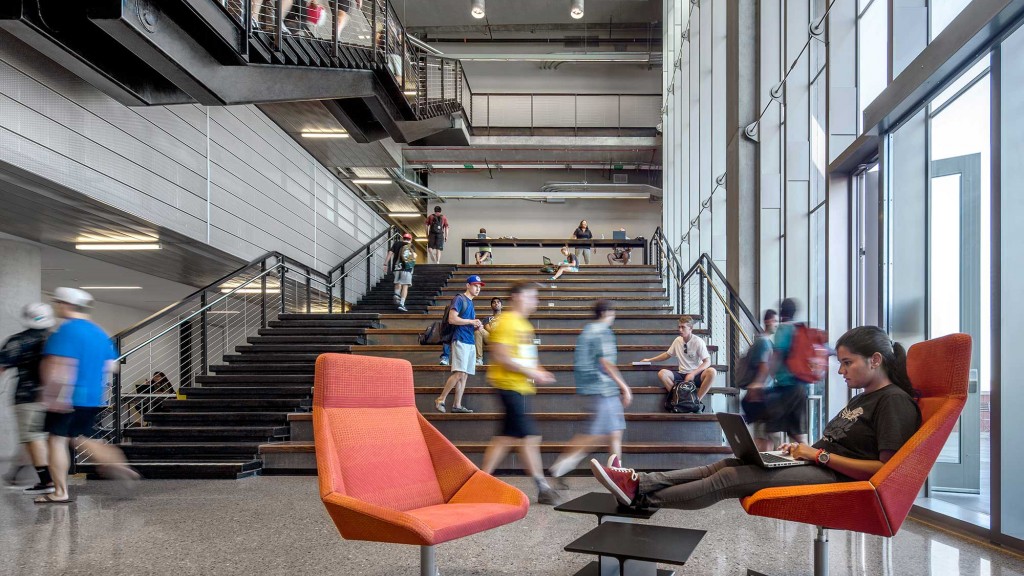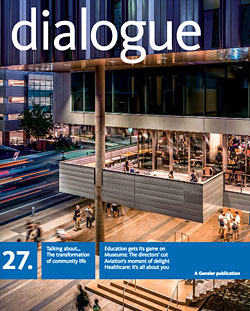A Student View of Academic Libraries
While much of their content is web accessible, libraries endure on the campus. New Gensler research looks at their current and future use.
University and college students put in three times more hours studying on their own than studying with peers, according to a recent survey of 1,200 US students, analyzed in Gensler’s Student Perspectives on the Library. The survey also confirms that extra study time correlates with better grades. Interestingly, while the A students put in the most hours, they use the library less than the B students. This suggests that the top performers are best able to screen out distraction. Whatever their performance level, students report that they prefer to study in the library. The main reason they give for this is straightforward: libraries offer places where they can focus, and focus makes their study time more effective.
The power of proximity
Given this preference, it’s surprising that two-thirds of students’ study time happens elsewhere. Their living situations may play a role: for individual study, students in dorms and campus housing prefer their own quarters slightly more than the library—with a slight gain in performance. Gensler’s research on student living confirms this: Students expect to find a live/work environment at on-campus dorms and housing. This often reflects study habits they established in high school.
Students’ study time also relates to where and how they live. Those living on campus spend the most time studying alone and the most time studying collaboratively. Those living within walking distance of campus also study slightly more than average, while those commuting to campus spend the least time on each activity. This suggests that commuters lack options about where to study, compared with their on-campus and near-campus peers. Providing more options that address their unique needs may be an important direction for libraries in the future.

The right resources—digital, physical, experiential
A related issue that Gensler investigated is whether printed books are still important to students or if they mainly access content as e-books or other digital, web-conveyed formats. The research found that students visit academic libraries more often to access digital resources than to check out printed books, but access to both outweighs socializing, attending events, or seeking help from librarians.
Asked about the relative importance of library resources, now and in the future, students reported a preference for digital resources (and integrated technology) over book collections. Research on library usage patterns, documented in Gensler’s Academic Libraries at a Crossroads, found that only 10 percent of students were observed using printed books, while 23 percent were using computers or tablets. The Gensler study Librarians on Libraries also points to academic libraries’ growing focus on digital resources. But parallel research suggests a more nuanced view of this issue. Naomi Baron of American University found “a near-universal preference for print,” with 92 percent of 300 students surveyed reporting that they concentrate best when working with print. A Student Monitor survey of 1,200 students also reported a preference for print for every type of study except research.
This suggests that the question of books versus digital resources is not an either/or proposition: students increasingly want easy access to digital tools and resources, but it would be premature for libraries to shed their collections.
Implications for the future
Academic libraries can benefit from a better understanding of how and why students use them. What they value, beyond the libraries’ book collections, are the ways that focused study and research is supported. “The competition for great study spaces on campus is fierce,” says Gensler’s Melissa Mizell. UC Berkeley’s Moffitt Library, which her team is renovating, accentuates libraries’ third place aspect: “the vibe, the slight din, the social component, being near others yet able to focus.”
Commuting students and those struggling academically are the most in need of libraries and their services, but are not currently the library’s heaviest users. To serve them better, libraries will have to give them more targeted attention in the future. One approach to consider is to provide places where commuters can easily access a variety of study settings and resources; another is to put in place a network of outreach facilities tailored to the special needs of lower-performing students.
Academic libraries will continue to evolve around core study and access needs. In this role, they will have to balance the energy of gathering with the need to support focused work. But they will also need to invest in new facilities that close the gap with students who aren’t being served by the current model. Adding spokes to the hub and integrating the digital more seamlessly are among the potential strategies.
Mark Thaler is a regional leader in Gensler’s Education & Culture practice, based in New York.
Tim Pittman, Gensler’s research communications manager, coedited its 2014 Research Catalogue.

